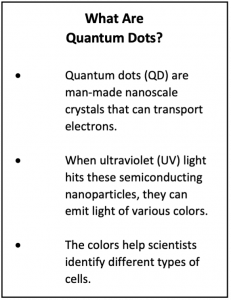Core Quantum Improves Laboratory Testing with Its MultiDots and MagDots
This story begins with an inspiring connection between two female scientists.
Dr. Jessica Winter, The Ohio State University (OSU) professor in chemical and biomolecular engineering, researched and developed a technology that creates fluorescent and magnetic nanoparticles used in research labs. Breast cancer interrupted her plan to commercialize.
Slowed down but not deterred, while receiving treatment, Dr. Winter pursued a patent. Her students entered the Fischer College of Business 2012 business plan competition with a business plan based on the technology. They won. Dr. Winter was awarded her patent, and, with in-kind services from the competition, Core Quantum Technologies was formed.
While all that was happening, Kristie Krug, microbiologist, inventor, and serial entrepreneur, had successfully started a company to commercialize and license her own nanoparticle technology for cell separation. Associates at the OSU Technology Commercialization Office introduced Krug and Winter in 2013. Krug worked with Core Quantum Technologies in an advisory role and then became CEO of the company in 2017.
Core Quantum Technologies Solves Unmet Need in Research and Clinical Pathology
Fluorescing dyes are widely used in research and diagnostic testing in laboratories worldwide to help scientists identify different types of cells using an instrument called a flow cytometer. The fluorescent reagents respond when put under specific wavelengths of light. Various pathologies react differently to different reagents and are used in tests for cancer, blood glucose, pregnancy, Covid 19, and many other conditions.
But all is not perfect in the lab. Fluorescing dyes fade, and traditional quantum dot reagents lost their fluorescence when transferred to cell-friendly solutions. Scientists need fluorescent reagents that offer more reliable, sensitive, and stable signal output to reduce clinical misdiagnosis, which can be as high as 28 percent.
Brighter, Steadier, and Clearer Quantum Dots

Core Quantum Technologies overcomes limitations of current technology with Multidots. These reagents are significantly brighter than traditional fluorescent reagents. They have tighter spectral emission, which reduces the overlap of colors providing better diagnostic certainty. They are also more stable than previous quantum dot reagents, providing a constant signal and retaining fluorescence in cell-friendly buffers.
“Our reagents save time, materials and increase the recovery of targeted cells,” Krug said.
Core Quantum loads multiple quantum dots into a protective polymer envelope while still retaining a nano-sized particle. MultiDots are therefore at least five times brighter than conventional quantum dots.
Additionally, Core Quantum Technologies offer unique MagDots, which combine fluorescent features with magnetic iron oxides within the same nanoparticle. MagDots are used for the magnetic separation of targeted cells, which reduces the time it takes to separate specific cells from hours to a 40-minute step without the need to re-label with a fluorescent reagent post magnetic enrichment.
Both MultiDots and MagDots are available by order to the research market here.

